This week, we take on your science questions, tackling the sticky subject of how glue works, the explosive potential of underground uranium and the problems with performance enhancing-football shirts. We look into gastroenteritis and find out how just one gram of vomit could infect one million people, and if that hasn't put you off your food, how acrylamide, found in toast and other tasty foods, may cause cancer. Plus, how the future of the paperback could be plastic, and in Kitchen Science we tell you the easy way to keep mirrors mist-free - using only soap!
In this episode
Getting stem cells to repair a broken heart
Scientists have discovered how stem cells can be used to prevent a fatal complication of heart attacks known as ventricular tachycardias.
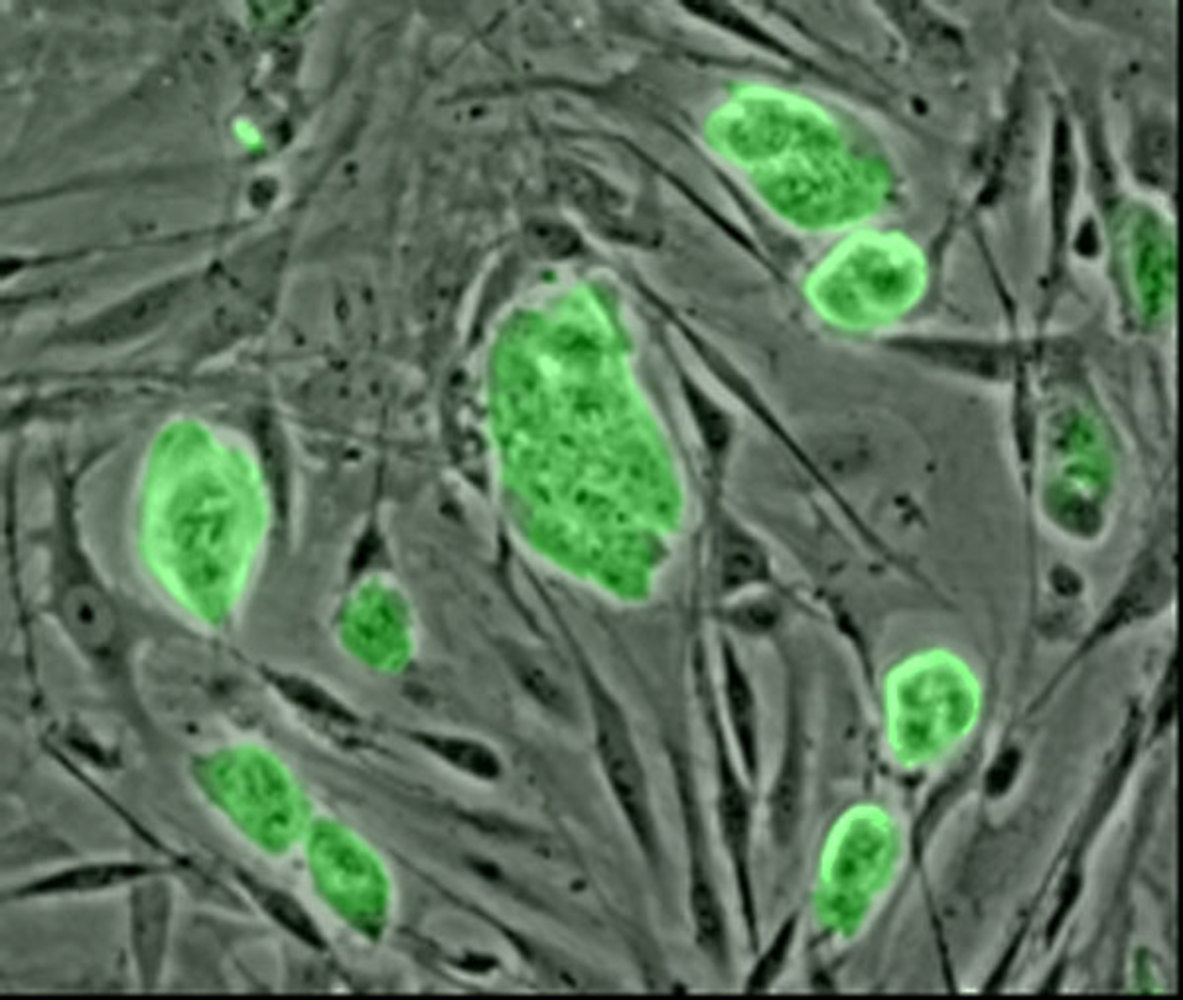 These disturbances of heart rhythm are the most common cause of death following a heart attack and they're caused by abnormal electrical activity in the part of the heart that's been damaged. But now, writing in this week's Nature, Bonn University researcher Wilhelm Roell and his colleagues think they know why, and how to use stem cells to prevent the problem from occurring.
These disturbances of heart rhythm are the most common cause of death following a heart attack and they're caused by abnormal electrical activity in the part of the heart that's been damaged. But now, writing in this week's Nature, Bonn University researcher Wilhelm Roell and his colleagues think they know why, and how to use stem cells to prevent the problem from occurring.
To simulate the damage done by a heart attack the team used a cold probe to make small lesions in the hearts of experimental mice. The animals were then divided into two groups. In one group the damaged region of the heart was immediately injected with stem cells that had been collected from either the developing leg muscles or hearts of embryonic donor mice. To make them easy to identify the donor cells were labelled with a green dye so that the team could follow where they went in the recipient animals. A second group of animals were not injected with stem cells and were followed up as controls. The researchers then tested the susceptibility of the animals to developing potentially fatal ventricular tachycardias (VT). The problem could be provoked in 100% of the control animals and the animals that received injections of muscle stem cells, but in only 39% of the animals that had received heart stem cells, making this group of animals no more susceptible to VT than healthy mice.
When they examined the animals' hearts the team found that the heart-derived stem cells, but not the muscle stem cells, were producing high levels of a protein called connexin 43, which electrically links heart cells together. In this way the donor cells were wiring themselves into the damaged heart and producing an electrical bridge across the injured area, so that the heart rhythm could continue to be conducted normally. To prove that this was the case the researchers then used genetic techniques to make muscle stem cells that were also capable of producing connexin 43. This time, when the cells were injected, the mice were much less vulnerable to VTs. On the basis of these results the team think that this technique could be used to save lives following heart attacks. The connexin gene could be added to stem cells collected from a patient who has just suffered a heart attack, and these cells could be injected into the injured heart, helping to ensure that it remains electrically stable.
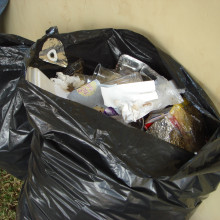
Biodegradable plastics? It's in the bag, say researchers
Scientists may have come up with a solution to the problem of how to tackle waste plastic pollution. They've borrowed from biology and then tweaked the recipe slightly to come up with a class of plastics that completely break down in the environment in a matter of weeks.
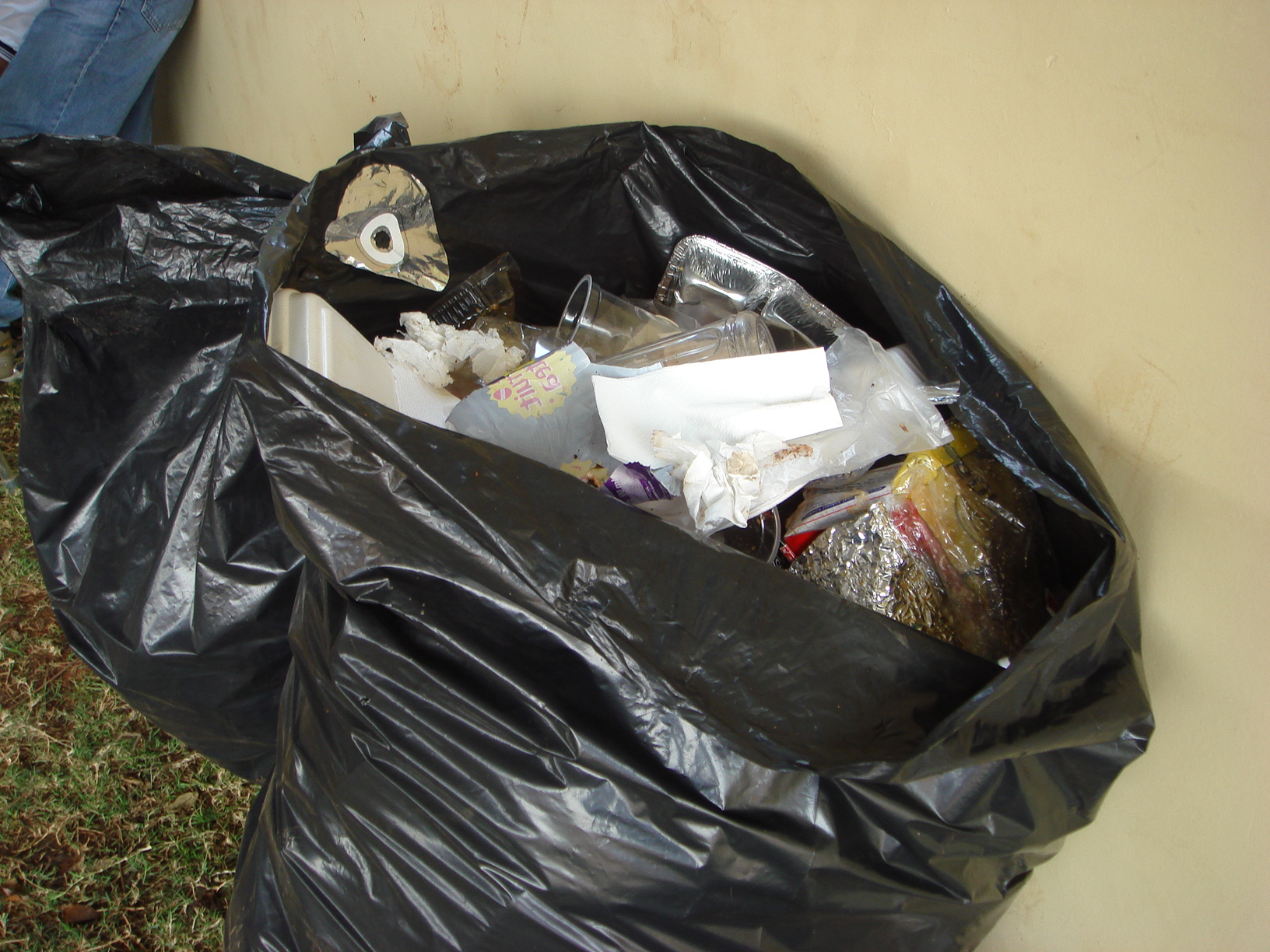 Cornell University's Emmauel Gianellis and his team used a natural polymer called poly 3-hydroxybutyrate (PHB), which is made by some microbes to store energy, in effect as the bacterial equivalent of body fat. But whilst PHB is degradable and biocompatible, its other chemical and mechanical properties are less ideal.
Cornell University's Emmauel Gianellis and his team used a natural polymer called poly 3-hydroxybutyrate (PHB), which is made by some microbes to store energy, in effect as the bacterial equivalent of body fat. But whilst PHB is degradable and biocompatible, its other chemical and mechanical properties are less ideal.
Now the Cornell team have found that by adding some silica (clay) nanoparticles they can significantly improve the degradability, barrier and chemical properties of the material, including making it tolerate higher temperatures, which makes it suitable for a larger range of potential applications.
The new composite behaved as a clear plastic polymer but broke down almost completely in compost, at room temperatute, within 7 weeks. And what makes it very attractive as a material is that it showed almost no degradation for the first 4 weeks, before then breaking down very rapidly. The team think that the more rapid breakdown is due to the spaces between the particles being more vulnerable to chemical attack and then consumption by microbes.

- Can diseases hit men and women differently?
Can diseases hit men and women differently?
We put this question to Jim Grey from the UK's Health Protection Authority. You can read and listen to the whole interview here.
Jim: Well, women probably have more infections because they have more contact with children. They change the nappies whereas the fathers rarely change the nappies. Its contact with the virus, really, that's causing the disease. Why children have milder disease than adults is because these viruses are circulating all the time in children. They're having multiple infections and therefore have some level of immunity to the virus, whereas the adults haven't seen this virus since they were a child, and therefore they have very low, or no, immunity to the virus.

Flying Saucers Around Saturn
Scientists have found two objects, a few kilometres across, orbiting Saturn that look like 1950's B movie flying saucers. Although there is no need to run for the hills (or possibly the mines) quite yet as they are just two moons of Saturn called Pan and Atlas orbiting in amongst Saturn's rings.
They are each approximately circular with a large bulge around their equator. This perculiar shape has only recently come to light with high resolution pictures coming from the Cassini spacecraft.
It is thought that they were formed with the rest of the ring as an icy body broke up newar to Saturn. The moons were in the centre of the ring, which is considerably narrower than the diameter of both moons. This meant that more material hit them on the equator than at the poles, so they grew a bulge around them middle.
Hopefully Cassini will be able to provide some even better pictures in the future.
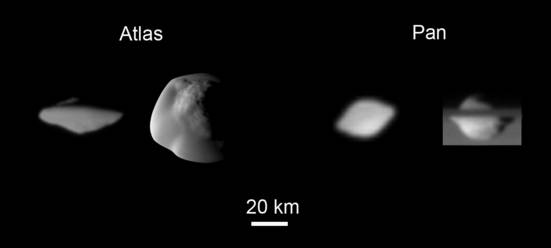
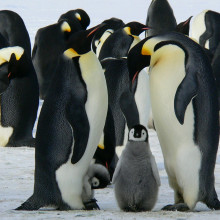
Emperor penguins run on almost empty
Those most familiar of birds that live in the south pole - the wonderful emperor penguins - have an ingenious method of grabbing every last bit of oxygen from their lungs to help them make incredible long dives into the icy waters of the Antarctic Ocean.
 That's according to new research from Paul Ponganis and his colleagues at the Scripps Institution of Oceanography in San Diego, California, who strapped oxygen sensors to diving penguins and found that they often come back up for air only when they have drained virtually all the oxygen from their lungs.
That's according to new research from Paul Ponganis and his colleagues at the Scripps Institution of Oceanography in San Diego, California, who strapped oxygen sensors to diving penguins and found that they often come back up for air only when they have drained virtually all the oxygen from their lungs.
In most animals a pigment in the blood called haemoglobin, absorbs oxygen from the air inside the lungs and is then pumped through the blood vessels around the body, delivering oxygen to different parts of the body. Usually, haemoglobin doesn't work very well at very low levels of oxygen, so the last bit is always left behind in the lungs even if an animal is starved of air.
This has lead researchers to think that the haemoglobin of emperor penguin must be a bit special, because it is able to mop up the very last dregs of oxygen in their lungs.
All in all it means that emperors - biggest of all the world's penguins - can make incredible 20 minute dives to over 500 metres down without causing any damage to their body tissues that other animals would suffer from because of a lack of oxygen.
And this means that we are one step closer to understanding how animals can endure such record breaking deep sea dives, and by studying the ability of the penguins to resist damage from low oxygen levels it is hoped that scientists may be able to learn more about how to help to prevent damage occurring to human tissues that are accidentally deprived of oxygen.

Gulf Stream Once Stopped
The gulf stream is the huge warm ocean current that moves water from the gulf of Mexico towards Northern Europe, brining with it heat equivalent to a million nuclear power stations running at full blast all year round, and is the reason why snow is rare in a British winter but at the same latitude on the other side of the Atlantic there are ice bergs floating in the sea.
 |
| Water temperatures in the West Atlantic, showing the Gulf stream as the warm band of water stretching to the NE. © NASA / JPL |
All this water moving north has to go somewhere, in the winter as ice is forming in the arctic, salt isn't taken into the ice so the sea water becomes more salty. This cold salty water then sinks and returns down the floor of the Atlantic. If this process is stopped then the Gulf Stream would slow down if not stop removing Europe's winter warmer.
Helga Kleiven at the University of Bergen had now found evidence of this very thing having happened 8000 years ago. At this time there was a huge lake covering most of the mid west of Canada called lake Agassiz containing 100 000 km3 of water (as a comparison all the fresh water lakes in the world today contain about 91 0000km3 of water). This Lake was formed as ice sheets and glaciers plugged the rivers which would normally drain this area into Hudson's Bay. But about 8000 years ago the glacial plug melted releasing most of this fresh water into the North Atlantic. Helga's team have found the sediment that this flood brought with it on the floor of the Labrador Sea. They have accurately dated this event and it coincides with an 8°C drop in temperature measured from Greenland ice cores. This very strongly indicates that it did have the effect of stopping the Gulf Stream.
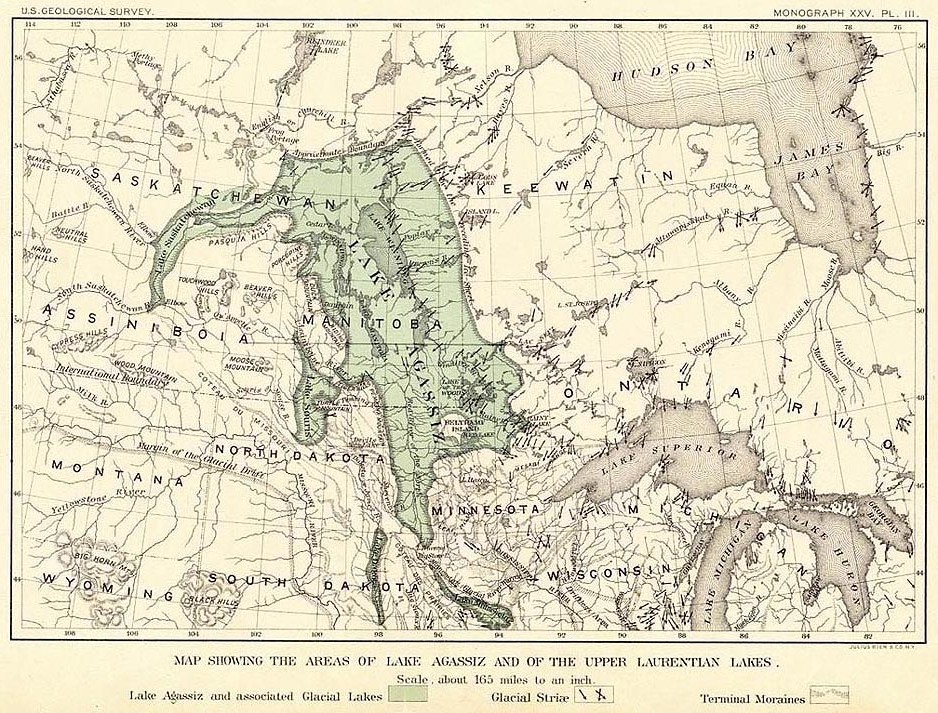
Scientists now have to work out how much water it would take to do the same thing again and whether global warming could melt enough of the Greenland Ice Sheet to have the same effect.
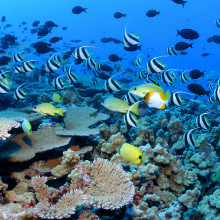
Pay out from Nature’s marine Bank helps alleviate poverty
We hear a lot these days (especially from Helen) about how we need to protect parts of our seas and oceans from all sorts of human impacts, including fishing and pollution, if we want to make sure that there are enough fish left in the future to feed ourselves - not to mention protecting nature and biodiversity for its own sake.
But it's really difficult to persuade governments to commit to paying for marine reserves or marine protected areas, and to encourage fishermen to leave some parts of the seas alone.
Now, a new joint study led by North America's Nature Conservancy along with several other conservation organisations and universities has demonstrated that marine conservation is strongly linked to human well-being and quality of life - they've shown that small, well-run marine reserves not only benefit wildlife but also can make a real difference to the lives of people's living close to areas of protected sea.
The study focused on Fiji, the Philippines, the Solomon Islands and Indonesia, where researchers conducted in-depth studies on the levels of health and income among people living near to four well-run marine reserves.
The key findings of the report were that when governments fund small reserves that are run by local communities, real benefits will emerge within just two to three years in terms of the amount of fish caught by fishermen, the income they earn and their overall quality of life.
All the study areas were in a dire state before the reserves were introduced, with fishermen struggling to make a living from dwindling fish stocks. But it took only a few years for the spill over of fish from the newly established reserves to boost fish catches outside the reserves and help dig the fishermen out of poverty.
The other piece of good news is that local people have also begun to see real benefits from the influx of divers who are increasingly visiting the beautiful, healthy coral reefs inside marine reserves. The extra income earned from tourism related activities are already being used to pay for better infrastructure in local communities, like water tanks and public toilets, which before couldn't be afforded.
This study has shown how important it is to have local people involved in managing their own marine reserves, giving them a sense of ownership and pride when they see the benefits of their actions.
It's hoped that this study will be shining light to encourage other marine reserves in developing countries to be set up and that governments will see that they make a huge difference by investing in their own marine banks - which ensure that not only the creatures in the seas but also the people living near the seas can lead better, healthier lives.
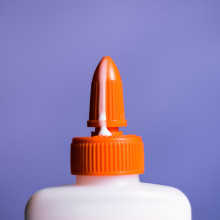
How does glue actually work?
Many things to do with chemistry are to do with electrons!
There are various ways in which glue can work: the simplest is that, if you have two slightly rough surfaces with tiny pits in them, putting a liquid which can set between them creates lots of little 'plugs' in the pits. Once it's set, you can't pull these out of the pits, so you can't pull the surfaces apart.
Alternatively, if you have two perfectly flat surfaces, they will tend to stick together by a force called the van der waals forces: the molecules of the surfaces tend to attract. Normal surfaces, though, will have dust or imperfections, and so cannot get close enough together to allow these forces to act.
If you put something "squidgy" - or fluid - between two surfaces - glue for example - it fills the lumps and bumps and allows the van der waals forces to act. This is the same way the geckos can stick to most surfaces, they have lots of tiny hairs on their toes which increase the surface area and allow van der waals forces to act, sticking them to walls, windows, ceilings etc.
Other glues chemically bond to surfaces, actually making molecular connections to both surfaces.
Why do Portuguese man-of-war jellyfish have more toxic stings at different times of the year?
We've never heard before that the actual amount of stings each jellyfish has would actually vary, but we certainly know there is annual variation in the amount of people who get stung. This is due to the annual variation in the number of jellyfish in the sea; they change over seasons and are often linked to blooms of plankton, their main food source. Recently there was a boom in the number of jellyfish around the UK, and this caused a big problem for fish farms around the coast.Another interesting fact - Portuguese man-of-war are actually not jellyfish, they are a form of colonial hydroid, lots of little tiny animals stuck together!
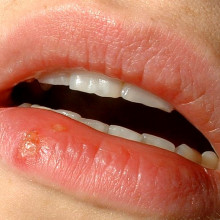
If you get cold sores and give blood, can the virus be passed on?
Good question. There's probably almost zero chance of that.
The virus that causes cold sores, the Herpes Simplex Virus (HSV), most of us acquire this when we're very young because of our parents kissing us and children dribbling over each other in nurseries - it spreads in saliva.
When you first get it, it produces a sore throat, ulcers in the mouth, swollen glands in the neck and a high temperature. It then invades the sensory nerves that supply your mouth and tongue, as well as other parts of the body it can infect. It goes inside these nerve cells and switches off. It exists there as a piece of DNA, loitering alongside the cell's own DNA, and periodically comes back to life.
We don't know exactly what triggers it to come back to life, but we know that things like damage to the skin, for example sunburn, menstruation, depression and immune depression, can bring it out again.
The virus turns back on its DNA, makes new virus particles which come down the nerve and pop out of the skin, causing the infectious lesion, the cold sore. When you kiss someone who's got one, that's how you pick it up.
Thankfully, it doesn't really get into the blood stream, so you should be safe from HSV from blood products. Other members of the herpes family do spread through blood, but not HSV.
Why is water in the ocean blue?
This is all to do with how water interacts with light. When water is a vapour in the atmosphere, the molecules are not glued together in the same way they are in a liquid. Water molecules tend to stick together with hydrogen bonds, but in a vapour they can spread out. In this state they are very good at soaking up infra-red light, but not visible light.When water forms a liquid - lots of molecules stuck together - it stiffens the bond between the hydrogen and the oxygen, and instead of absorbing infra-red, it now absorbs light at the red end of the spectrum. White light is a mixture of lots of different wavelengths, and if you take out some of the red light, it looks a little bluer. The more water you have, the more red is absorbed and the bluer things look.
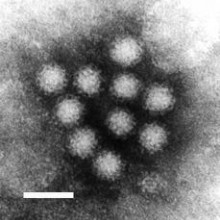
24:57 - Gastroenteritis and Noroviruses
Gastroenteritis and Noroviruses
with Dr Jim Grey, Health Protection Agency
In the East of England recently we've had a big outbreak of a problem caused by Norovirus, a virus that causes vomiting and diarrhoea. Jim was affectionately called 'the poo man' by one of his colleagues, and he came in to speak to us about what causes these outbreaks...
Chris - So what actually is this virus?
Jim - Right, norovirus has previously been called the small round structured virus (SRSV) or the Norwalk-like virus. It's an RNA virus and is actually a very stable virus. It requires a low infectious dose to cause gastroenteritis, there's a short incubation period associated with this disease and there are multiple transmission routes; so you could have transmission from person to person, through food, through water or from environmental surfaces.
Chris - So how long after you catch it do you start to feel unwell?
Jim - About 24 hours.
Chris - Oh, so it's very quick!
Jim - Very quick.
Chris - So how does it actually spread then?
Jim - It's spread usually by contact with someone who's infected, or someone contaminating food or water or contaminating surfaces, anything that they touch with their hands.
Chris - And so once you take the virus into your body, talk us through what actually happens next?
Jim - The virus obviously gets into the gut and begins to replicate. The interesting thing about norovirus is the site that it replicates at is the site where you have the disease, and therefore there is no lag time - there's no time for the immune system to react before the virus starts to replicate. And so everyone will be constantly infected throughout life.
Chris - And so every single body product, both vomit and diarrhoea, is highly infectious?
Jim - In a gram of faeces or a gram of vomit there are probably about a million infectious doses. So you could infect a million people with a gram.
Chris - Wow, that's a lot, isn't it?
Jim - Yeah.
Chris - I've got an email here from Nick, who's in Boston. And he says:
"We've had a bit of an epidemic here around Boston these last two months, and I've been getting into some trouble with my feminist friends for saying this, but of all those I know who've gotten it, the women have been hit far worse than the guys. For instance, I had a very upset stomach for a couple of days, and our 2-year old son vomited once but otherwise seemed almost fine, but my wife was violently ill for a day, had it coming out both ends if you know what I mean. I know two other couples with similar experiences."
Why should this be?
Jim - Well, women probably have more infections because they have more contact with children. They change the nappies whereas the fathers rarely change the nappies. Its contact with the virus, really, that's causing the disease. Why children have milder disease than adults is because these viruses are circulating all the time in children. They're having multiple infections and therefore have some level of immunity to the virus, whereas the adults haven't seen this virus since they were a child, and therefore they have very low, or no, immunity to the virus.
Chris - So why are we seeing big outbreaks of this? There are lots of causes of food poisoning, why is this one doing the rounds at the moment?
Jim - Because it's an RNA virus, it has the ability to mutate quite readily and therefore be selected, and so what you see here are variants of the virus circulating. As the population develops immunity to those viruses, a new virus is selected. So we se waves of epidemics probably every two or three years across the world as a new virus is selected. It's very much like influenza, we see exactly the same thing with influenza, every two or three years a new variant is selected. And so all these RNA viruses are susceptible to mutation.
Chris - How do we avoid getting it, Jim?
Jim - Good hygiene! Wash your hands I think is probably the best approach, I think. There is no real prospect for a vaccine for this virus because of the rate of mutation - you would need to have a vaccine for every year. And so the best approach is good hygiene, as the virus is usually passed on by touching, so wash your hands. If someone in the house is ill, then make sure that you wash down surfaces, that you use a weak solution of bleach, to wash down surfaces, that'll kill the virus.
Chris - I work in a hospital as a virologist, and I was shocked when someone pointed out to me all these wonderful alcohol hand rubs that we should be using on all the wards, and they actually said to me 'that doesn't affect norovirus at all'.
Jim - That's right. Alcohol will usually attack a surface that contains a lipid. Norovirus is protein, there's no lipid in norovirus so all you're doing is moving the virus around a surface using alcohol.
Chris - So soap and water is the order of the day.
Jim - Exactly.

30:02 - Paperless Paperbacks?
Paperless Paperbacks?
with Chris Vallance
Now, Books make great presents, which is why so many new books come out in the run up to Christmas. In this month's Technology segment, Chris Vallance tells Meera that the future of books may not be on paper...
 Chris Vallance - I've been looking at the future of books, I was inspired to do this because of the launch of Amazon's kindle; it was launched on November the 19th, Kindle is Amazon's electronic book reader, this is the device that we've all been waiting for since the 1960's, the wonderful science fiction tablet that would contain the entire British library and you would be able to search through it and look at any book you wanted.
Chris Vallance - I've been looking at the future of books, I was inspired to do this because of the launch of Amazon's kindle; it was launched on November the 19th, Kindle is Amazon's electronic book reader, this is the device that we've all been waiting for since the 1960's, the wonderful science fiction tablet that would contain the entire British library and you would be able to search through it and look at any book you wanted.
Well, the kindle offers you the opportunity to download books, it's got an innovative screen that's not going to give you that sort of blinding glare that laptops give you, and it will give you the opportunity of reading newspapers and some blogs. But it's had mixed reviews; Robert Scoble, the big Microsoft blogger, one of the leading thinkers in the tech industry didn't like it; he found it really hard to hold and use the device. Joel Johnson writing for Boing Boing said the $400 price tag was too high, and the cost of getting blogs, $2 a month, and newspapers $15 a month, was simply too high. So some real mixed reviews there. Very popular - sold out when it was launched, but at the same time a lot of people saying this isn't quite the e-book reader that maybe we've been hoping for, that we still believe can be built.
Meera - So if that wasn't your cup of tea, what else is out there for people to go to?
Chris Vallance - Well I think you don't have to have a swanky e-book reader to access literature online. Maybe you just need an MP3 player. There is this wonderful site, Librivox, which has public domain works which you can listen to as podcasts; stuff like this:
A sample of Tom Swift and The Visitor from Planet X, by Victor Appleton II. From Librivox.org
Tom Swift! And the Visitor from Planet X! By Victor Appleton II, Chapter Nine, The cave monster!
"Skipper!" Bud cried anxiously as tom staggered back, his hands to his face.
"I'm alright, no harm done" Tom assured his friend. Both boys were a bit shaken by the accident...
Chris Vallance - So things like that may or may not be your cup of tea. More things; new novels at podiobooks, or maybe you would like to have a go at writing a book yourself - there is annually the 'NaNoWriMo' event (National Novel Writing Month), which tries to encourage people to write a book in a month, bit of a challenge, that.
Or maybe you want to help somebody else write a book? There are a lot of authors now who are blogging, you may have seen Naomi Novik's books, the Temeraire series about dragons, she has a very interesting live journal blog. And also, let's not forget fan-fiction - people inventing new storylines for established characters. Again, you might find something that tickles your fancy there. All of this stuff is free!
Meera - So all that is available online, but what is the future of the publishing industry itself?
Chris Vallance - Well I have to say I don't know, but I've been talking to somebody who does. Lulu.com is one of the most innovative web 2.0 publishing houses, basically Lulu allows people to publish very small runs of books and to distribute them online and to market them online. Bob Young is their chief executive and well, we've seen how the music industry has been revolutionised by the web and how music companies are struggling to figure out how they're going to make money, so talking to Bob Young, I asked him if the publishing industry is going to face the same kind of challenges.
Bob Young - I'm not going to deny that we are all, in our modern society, as businessmen subject to a huge amount of change. And you can either embrace it, try and innovate on behalf of your customers because keep in mind the problem is being created at the expense of the suppliers, but on behalf of the consumer. Using the internet they're able to get better value for themselves than they were ever able to in the traditional model where the only way to buy a song was to drive across town to a record store and you bought 20 songs on a CD. But you wanted the songs on your walkman, or your electronic device. And then along comes the internet and suddenly you can download the song direct from the site directly, and you can buy that song for 50p each, in stead of £20 for 20 songs, 19 of which you don't want, on a piece of plastic that doesn't do you any good.
Chris Vallance - But I just wonder what the solution is? Books take such a long time to write, there's such an investment in them that I can't just give it away, I need people to pay quite a bit for even a low volume book for it to be worth my even considering writing it.
Bob Young - That's right, but keep in mind that books are very different items than music. So two things we know - one is that services such as Amazon and Sony both have e-book readers, and you can read things on your computer. We know things are going to change. Equally we know that they will not change in the same way that other things change because it's a different form of content. You have to invest many, many hours to consume a book whether it's a detective story or a reference manual on quantum mechanics. I'm not 100% sure what the future of the book industry is, all I do know is that it's very bright. As we educate our world to a higher and higher standard, we're creating ever more readers of books. You and I are spending more money on intellectual property; books, music, videos; than our parents did, and dramatically more than our grandparents did. We're now spending our money on things that we consume with our mind as opposed to physical objects.
Chris Vallance - So that was Bob Young, the CEO of Lulu.com in bullish mood about the opportunities for publishing creative content online. One interesting thing he said to me is that books aren't just digital media, it's not just the text, it's also the physical product as well. Anybody who's seen a really nicely bound old book or a new book that somebody has taken a real care over the design and the look and the feel of it - it's a product that you can't really copy in the same way. And that again is another challenge for e-books and another challenge for things like the Kindle, recreating the look and the feel and the physical product.
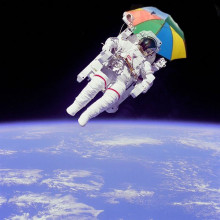
Why can small masses do damage in space?
There are two concepts involved here, which are very often confused. One of them is weight, which is how heavy things feel, and the other is mass. Mass can be considered as being how hard it is to accelerate or stop things. It just happens that the bigger the mass, the heavier the weight, i.e. the amount they are attracted to the Earth; this is because weight is a product of the mass and the strength of gravity.In orbit, you take away the weight but the mass is still there. This means that if you try to start it moving, or stop it moving, it's very difficult. So if you were to throw a hammer at someone on the shuttle, although it's weightless it will still have mass and inertia, and so it will still hurt when it hits!
Charged shirts and thunderstorms?
We put this question to Mark Peplow, editor of Chemistry World Magazine.
I have to say I'm fairly sceptical. What they're saying is that somehow, negative ions, anions, are being generated by the shirt and this is having an effect on blood flow in the bodies of the players that wear the shirts. When you actually read down the story, their reporting a supposed improvement in mean performance of 2.7% and that's probably quite hard to judge anyway. But that level of improvement, 2.7%, one can imagine a performance boost coming from the positive moral of wearing a high-tech shirt, so I have to say I'm a little sceptical about this.
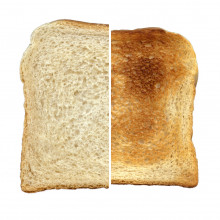
39:46 - Acrylamide & Heart Surgery
Acrylamide & Heart Surgery
with Mark Peplow, Chemistry World
Chris - Well it's that time again where we catch up with Mark Peplow. He's the editor of Chemistry World, from the Royal Society of Chemistry; they're based in Cambridge and Mark's here to give us an update on what's hot this month in the world of chemistry.
What's this about food and acrylamide?
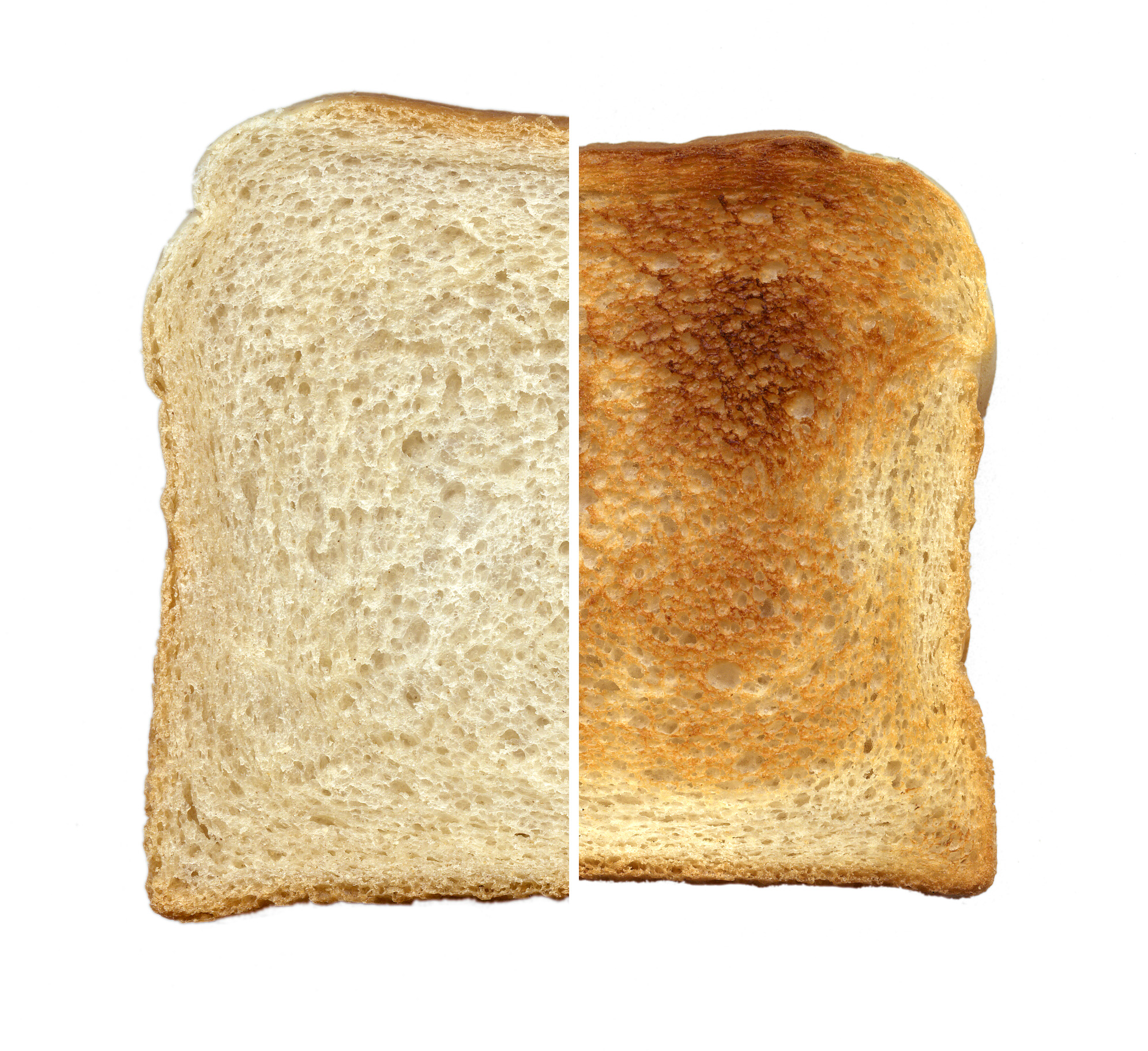 Mark - This is the next chapter of a really interesting story that's been running for 5 years. This week, scientists published the first study that's ever confirmed the long proposed link between a compound called Acrylamide and cancer. Now, acrylamide might sound like a scary thing but it's actually fairly common in very small amounts in an awful lot of foods. Its produces, whenever you make food that goes toasty. Anything you're making that has a nice brown crispiness to it, and tastes good unfortunately, then its got acrylamide in it. It's generated by this reaction called the Maillard reaction, and it's basically a reaction between certain types of amino acid and some sugars, and it really kicks into action above 120 degrees. You particularly find it in crisps, and biscuits and pastries and chips, and things like that.
Mark - This is the next chapter of a really interesting story that's been running for 5 years. This week, scientists published the first study that's ever confirmed the long proposed link between a compound called Acrylamide and cancer. Now, acrylamide might sound like a scary thing but it's actually fairly common in very small amounts in an awful lot of foods. Its produces, whenever you make food that goes toasty. Anything you're making that has a nice brown crispiness to it, and tastes good unfortunately, then its got acrylamide in it. It's generated by this reaction called the Maillard reaction, and it's basically a reaction between certain types of amino acid and some sugars, and it really kicks into action above 120 degrees. You particularly find it in crisps, and biscuits and pastries and chips, and things like that.
This study basically involved 62,000 women that were monitored in Holland over 11 years. It's quite a substantial study, and what the scientists found was that if they had high levels of acrylamide in their diet, that effectively doubled their risk of developing womb or Ovarian cancer. Now that sounds a little scary, but the levels of risk for those cancers are extremely low, so even doubling the risk doesn't mean there's huge swathes of people dying from intaking fried foods and things like that.
Chris - But shouldn't that at the same time give the take home message 'Eat less of it' then?
Mark - Well Cancer Research UK were very quick this week to reassure women that they shouldn't be scared by these findings. But ultimately the advice has to be, that if you are concerned by these sorts of things, it's yet another reason really to try and eat more fruit and vegetables and less fried foods.
Chris - Well lets hope so, because I quite like my fried foods. In moderation of course. Now, if you eat a lot of fried foods though, one thing it'll do is clog your arteries up and in recent years doctors have begun to unblock arteries with angioplasties. This is threading a catheter into a blocked artery and inflated a balloon to open it. And then they starting adding stents, these frames you can deploy inside the artery to keep it open. What's the story on that now?
Mark - Well this is quite interesting. Like you say Stents have been used, their kind of like little bits of scaffolding that you put inside blocked arteries to hold them open. But, over the last year some concerns have been rising about stents and fears that they may increase the risk of clotting, although a lot of the stents are coated, the threads of metal are coated in a polymer which releases anti-clotting drugs when they're in the body. These don't last for very long, they tend to wear out and so in longer-term studies people are starting to see a problem with these things. We had a correspondent go to a material research society meeting in America a couple of weeks ago where there's two new developments in making stents. One of them effectively creates a rubber ball, rather than using this metal framework, it creates an elongated rubber ball with a metal spring inside it, and it's the polymer itself that the ball is made out of, which stops clotting and ensures that you can have the stents inside the body for much longer. These have been tested so far in pigs and rats and it seems to make a substantial difference in terms of their effectiveness.
The other research that came up is that, one of the problems with this is that you have to have a metal coil inside this, holding it into shape. Scientists are now working on 'shape-memory polymers' which will pack up tightly at room temperature, about 20 degrees, into a tiny thread, but when they actually get into the, the body temperature which is higher than room temperature makes them unfurl into their own scaffolding. So there's no metal required, and what that means is that it doesn't stretch the arteries quite as much when you're putting it in there. Ti expands to fit into the arteries a lot cleaner.
Chris - That sounds exciting, thanks Mark.
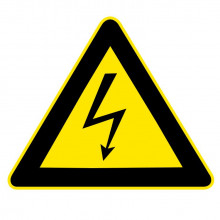
44:17 - The Electrified Car Hop?
The Electrified Car Hop?
This question was answered by Dr Richard McMann from Cambridge University's department of electrical engineering.
The questioner asks for safety advice about what to do if a 23,000V power line falls across your car. The advice given was to get out quickly as first the tyres and then the whole vehicle would set on fire. At 23,000 volts the vehicle tyres will effectively insulate the vehicle and it acts as a so-called faraday cage. You're perfectly safe inside. Your tyres will not on fire in the time it takes a circuit to disconnect. I do wonder though if there's a mistake in the question. In power transmission, high tension will be more like 230,000 volts. In this case the stories a bit different and the current would jump to earth. This effect was shown recently on a popular television programme, where one of the two long suffering assistants was volunteered to be subjected, in a car of course, to a strike of about a million Volts. After 10 seconds of such shocks, the car started and the assistant escaped unscathed. So, if a power line was to fall on our vehicle, assuming we were to survive any mechanical damage, such as broken glass as power lines are pretty heavy, the thing to do is to be well advised to stay put safely inside our Faraday cage until any arching has stopped. In fact, circuit breakers should disconnect permanently in a second or so. So what do we do then? One of my students suggested driving away to dislodge the cable. This seems a good tactic and if we can get free, we can get out safely. If you can't do that, you've got a choice of jumping out or waiting for the rescue services. You can't be absolutely sure that the cable is definitely dead.Finally, your chances of experiencing this life changing event are very, very small. However, if you're of a nervous disposition, avoid parking under power lines.
Are Plutonium and Uranium found in the ground?
Plutonium is not found in the ground. All the Plutonium we use is artificially made in a nuclear reactor. Uranium is found in the ground. Today it would be very difficult to accidentally create a nuclear explosion, or a nuclear reactor, because there's very little of the active form, Uranium-235, left. It's slowly decaying away, and the longer we leave it the less there is.A couple of billion years ago, there was a case where some bacteria concentrated Uranium underground in Africa, and we have since discovered that it did form a nuclear reactor. The reaction caused the area to get so hot that it killed off the bacteria, and so stopped them from concentrating more Uranium.A lot of the heat locked away in the core of the Earth is thought to be the result of radioactive decay of things like Thorium and radioactive Potassium, but this doesn't have the chain reaction that a nuclear reactor does have.
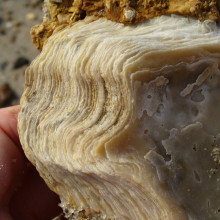
Can one tell from layers how long an oyster lived?
You probably can date shellfish in this way, and that would suggest that this shell was 52 years old. Like many things in nature, shellfish have annual seasons of rapid growth, and during this far more shell is laid down. This way, you can probably count shell layers just as you would count tree rings.

How can Helen wake up on time?
A little while ago, Helen said on the show that she had trouble getting up in the morning, and that in particular she hates alarms which wake her suddenly. This spawned a huge email response with possible solutions for her, including:
Jen Brokeman in Columbia recommends a system that uses natural sounds which gradually get louder to wake you gently.
Also Kara Sentance, Catherine Meissner in Washington and Martyn Holden in Scandinavia, all suggested an alarm clock which has a progressive light, which switches on 30 minutes before you want to wake up, and gradually increases in brightness - like having a sunrise on your bedside table!
Thanks everyone!
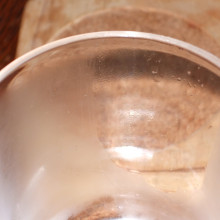










Comments
Add a comment